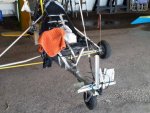Rasool
Junior Member
- Joined
- Jul 14, 2016
- Messages
- 114
- Location
- Greensboro, North Carolina, USA
- Aircraft
- Magni M-22
- Total Flight Time
- 220 fixed wing, 210 gyro
I have an Icom A6 radio and need to purchase and install an antenna on my Dominator single. Does anyone fly a Dominator single with a dipole antenna? If so, how and where did you mount it. I think I could mount a dipole effectively on the main landing gear strut, but it would look goofy, to be honest. And since I am only doing local flying, I don't think I need the (supposed) increased range of a dipole antenna. I am leaning towards a 1/4 wave whip antenna which I could mount above or below on the forward pod. This would, frankly, look much better, and probably work just fine for my needs. Please respond with any thoughts, opinions, photos, etc.
Thanks,
Russ
Thanks,
Russ

